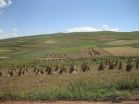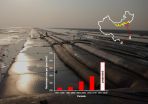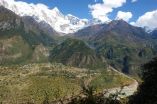(Press-News.org) Animal teeth, bones and plant remains have helped researchers from Cambridge, China and America to pinpoint a date for what could be the earliest sustained human habitation at high altitude.
Archaeological discoveries from the 'roof of the world' on the Tibetan Plateau indicate that from 3,600 years ago, crop growing and the raising of livestock was taking place year-round at hitherto unprecedented altitudes.
The findings, published today in Science, demonstrate that across 53 archaeological sites spanning 800 miles, there is evidence of sustained farming and human habitation between 2,500 metres above sea level (8,200ft) and 3,400 metres (11,154ft).
Evidence of an intermittent human presence on the Tibetan Plateau has been dated to at least 20,000 years ago, with the first semi-permanent villages established only 5,200 years ago. The presence of crops and livestock at the altitudes discovered by researchers indicates a more sustained human presence than is needed to merely hunt game at such heights.
Professor Martin Jones, from Cambridge's Department of Archaeology, and one of the lead researchers on the project, said: "Until now, when and how humans started to live and farm at such extraordinary heights has remained an open question. Our understanding of sustained habitation above 2-3,000m on the Tibetan Plateau has to date been hampered by the scarcity of archaeological data available.
"But our findings show that not only did these farmer-herders conquer unheard of heights in terms of raising livestock and growing crops like barley and millet, but that human expansion into the higher, colder altitudes took place as the continental temperatures were becoming colder.
"Year-round survival at these altitudes must have led to some very challenging conditions indeed - and this poses further, interesting questions for researchers about the adaptation of humans, livestock and crops to life at such dizzying heights."
Professor Jones hopes more work will now be undertaken to look at genetic resistance in humans to altitude sickness, and genetic response in crop plants in relation to attributes such as grain vernalisation, flowering time response and ultraviolet radiation tolerance - as well as research into the genetic and ethnic identity of the human communities themselves.
Research on the Tibetan Plateau has also raised interesting questions about the timing and introduction of Western crops such as barley and wheat - staples of the so-called 'Fertile Crescent'. From 4,000-3,600 years ago, this meeting of east and west led to the joining or displacement of traditional North Chinese crops of broomcorn and foxtail millet. The importation of Western cereals enabled human communities to adapt to the harsher conditions of higher altitudes in the Plateau.
In order to ascertain during what period and at what altitude sustained food produced first enabled an enduring human presence, the research group collected artefacts, animal bones and plant remains from 53 sites across the late Yangshao, Majiayao, Qiija, Xindian, Kayue and Nuomuhong cultures.
Cereal grains (foxtail millet, broomcorn millet, barley and wheat) were identified at all 53 sites and animal bones and teeth (from sheep, cattle and pig) were discovered at ten sites. Of the 53 sites, an earlier group (dating from 5,200-3,600 years ago) reached a maximum elevation of 2,527m while a later group of 29 sites (dating from 3,600-2,300 years ago) approached 3,400m in altitude.
Professor Jones believes the Tibetan Plateau research could have wider and further-reaching implications for today's world in terms of global food security and the possibilities of rebalancing the 'global diet'; at present heavily, and perhaps unsustainably, swayed in favour of the big three crops of rice, wheat and maize.
He said: "Our current knowledge of agricultural foods emphasises a relatively small number of crops growing in the intensively managed lowlands. The more we learn about the rich ecology of past and present societies, and the wider range of crops they raised in the world's more challenging environments, the more options we will have for thinking through food security issues in the future."
INFORMATION:
China's second great wall, a vast seawall covering more than half of the country's mainland coastline, is a foundation for financial gain - and also a dyke holding a swelling rush of ecological woes.
A group of international sustainability scholars, including Jianguo "Jack" Liu, director of Michigan State University's Center for Systems Integration and Sustainability, in a paper published today in Science magazine, outline the sweeping downsides of one of China's efforts to fuel its booming economy, downsides that extend beyond China.
China's coastal regions are only ...
The Himalaya features some of the most impressive gorges on Earth that have been formed by rivers. The geologic history of the famous Tsangpo Gorge, in the eastern Himalaya, now needs to be rewritten.
A team of German, Chinese, and American geoscientists have namely discovered a canyon, filled with more than 500 m of sediments beneath the bed of the present-day Yarlung Tsangpo River upstream from the gorge. Using drill cores, the scientists were able to reconstruct the former valley floor of this river, which allowed them to reconstruct the geological history of the Tsangpo ...
Doctors have long been mystified as to why HIV-1 rapidly sickens some individuals, while in others the virus has difficulties gaining a foothold. Now, a study of genetic variation in HIV-1 and in the cells it infects reported by University of Minnesota researchers in this week's issue of PLOS Genetics has uncovered a chink in HIV-1's armor that may, at least in part, explain the puzzling difference -- and potentially open the door to new treatments.
HIV-1 harms people by invading immune system cells known as T lymphocytes, hijacking their molecular machinery to make more ...
A team of researchers from Caltech and the China Earthquake Administration has discovered an ancient, deep canyon buried along the Yarlung Tsangpo River in south Tibet, north of the eastern end of the Himalayas. The geologists say that the ancient canyon--thousands of feet deep in places--effectively rules out a popular model used to explain how the massive and picturesque gorges of the Himalayas became so steep, so fast.
"I was extremely surprised when my colleagues, Jing Liu-Zeng and Dirk Scherler, showed me the evidence for this canyon in southern Tibet," says Jean-Philippe ...
Bangkok (Thailand)- A recent study from the Thai-Myanmar border highlights the severe and previously under-reported adverse impact of readily treatable tropical rickettsial illnesses, notably scrub typhus and murine typhus, on pregnancy outcomes, finding that more than one third of affected pregnancies resulted either in stillbirth or premature and/or low birth weight babies.
Conducted by Prof Rose McGready and Assoc. Prof Daniel Henry Paris from the Shoklo Malaria Research Unit (SMRU) in Mae Sot, Thailand, and the Mahidol Oxford Research Unit (MORU) in Bangkok, affiliated ...
LEXINGTON, Ky. (Nov. 20, 2014) - A landmark study published today in the journal Science by an international group of scientists, led by the laboratory of Dr. Jayakrishna Ambati, professor & vice chair of the Department of Ophthalmology & Visual Sciences at the University of Kentucky, reports that HIV/AIDS drugs that have been used for the last 30 years could be repurposed to treat age-related macular degeneration (AMD), as well as other inflammatory disorders, because of a previously undiscovered intrinsic and inflammatory activity those drugs possess.
AMD is a progressive ...
Scientists developed a new method which allows to estimate the magnetic field of a distant exoplanet, i.e., a planet, which is located outside the Solar system and orbits a different star. Moreover, they managed to estimate the value of the magnetic moment of the planet HD 209458b.The group of scientists including one of the researchers of the Lomonosov Moscow State University (Russia) published their article in the Science magazine.
In the two decades which passed since the discovery of the first planet outside the Solar system, astronomers have made a great progress ...
MADISON, Wis. -- As real as that daydream may seem, its path through your brain runs opposite reality.
Aiming to discern discrete neural circuits, researchers at the University of Wisconsin-Madison have tracked electrical activity in the brains of people who alternately imagined scenes or watched videos.
"A really important problem in brain research is understanding how different parts of the brain are functionally connected. What areas are interacting? What is the direction of communication?" says Barry Van Veen, a UW-Madison professor of electrical and computer engineering. ...
MADISON, Wis. - The influenza virus, like all viruses, is a hijacker. It quietly slips its way inside cells, steals the machinery inside to make more copies of itself, and then -- having multiplied -- bursts out of the cell to find others to infect.
Most drugs currently used to treat influenza are designed to attack the virus, to render it incapacitated. But influenza viruses are sneaky, capable of mutating to avoid destruction by the drug.
In a comprehensive new study published today in the journal Cell Host and Microbe, the University of Wisconsin-Madison's Yoshihiro ...
EUGENE, Ore. -- Nov. 20, 2014 -- A potential path to identify imperfections and improve the quality of nanomaterials for use in next-generation solar cells has emerged from a collaboration of University of Oregon and industry researchers.
To increase light-harvesting efficiency of solar cells beyond silicon's limit of about 29 percent, manufacturers have used layers of chemically synthesized semiconductor nanocrystals. Properties of quantum dots that are produced are manipulated by controlling the synthetic process and surface chemical structure.
This process, however, ...





